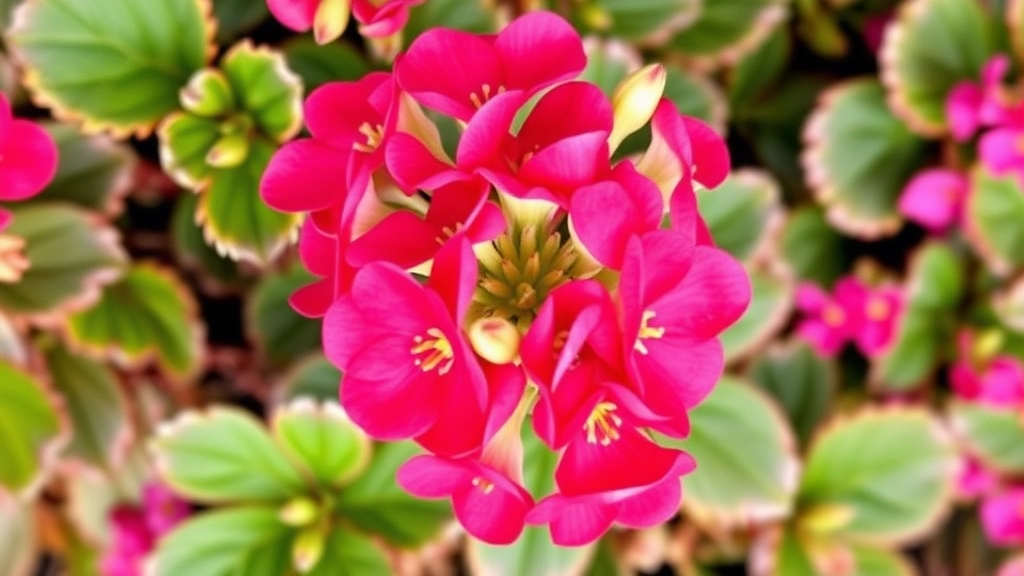Kalanchoe Species Identification
When it comes to Kalanchoe species identification, knowing the key features is essential. From leaf shapes and textures to flowering patterns, these traits help distinguish between the numerous varieties. Whether you’re a plant enthusiast or a gardener, understanding these characteristics can make all the difference in correctly identifying and caring for your Kalanchoe plants.
Popular Kalanchoe Species
Popular Kalanchoe species like Kalanchoe blossfeldiana and Kalanchoe tomentosa offer unique traits that make them favourites for home gardening. However, differentiating between common and rare varieties can be tricky. By focusing on specific markers such as leaf structure and seasonal changes, you can master the art of Kalanchoe species identification and ensure your plants thrive.
Key Features for Identifying Kalanchoe Species
Identifying Kalanchoe species can often feel overwhelming, especially with the variety of shapes, sizes, and colours they offer.
What should you look for when trying to pinpoint the exact species in your collection or at a nursery?
1. Leaf Characteristics
- Shape: Kalanchoe leaves can be oval, lanceolate, or even scalloped.
- Texture: Some species have smooth, glossy leaves, while others may be fuzzy or have a waxy coating.
- Colour: Ranging from deep green to variegated patterns, the leaf colour can be a significant identifier.
2. Flower Structure
- Type of Flowers: Kalanchoe flowers come in clusters and can vary in shape from tubular to star-like.
- Colour: Common hues include pink, red, yellow, and white. The colour of the flowers often helps in distinguishing between species.
- Blooming Season: Note when the plant flowers; some species bloom in winter, while others might flower in spring or summer.
3. Growth Habit
- Size and Form: Some Kalanchoe species are compact and bushy, while others may grow tall and leggy.
- Stem Structure: Observe whether the stems are thick and fleshy or thin and wiry.
4. Geographic Origin
Understanding the native habitat of a Kalanchoe species can provide insights into its specific adaptations and care requirements. For detailed care tips, you might find our expert tips for healthy growth of Kalanchoe beharensis particularly useful.
Additionally, if you are interested in learning about the care and propagation of specific Kalanchoe varieties, check out our complete guide to growing Kalanchoe Mother of Thousands.
Popular Kalanchoe Species for Home Gardening
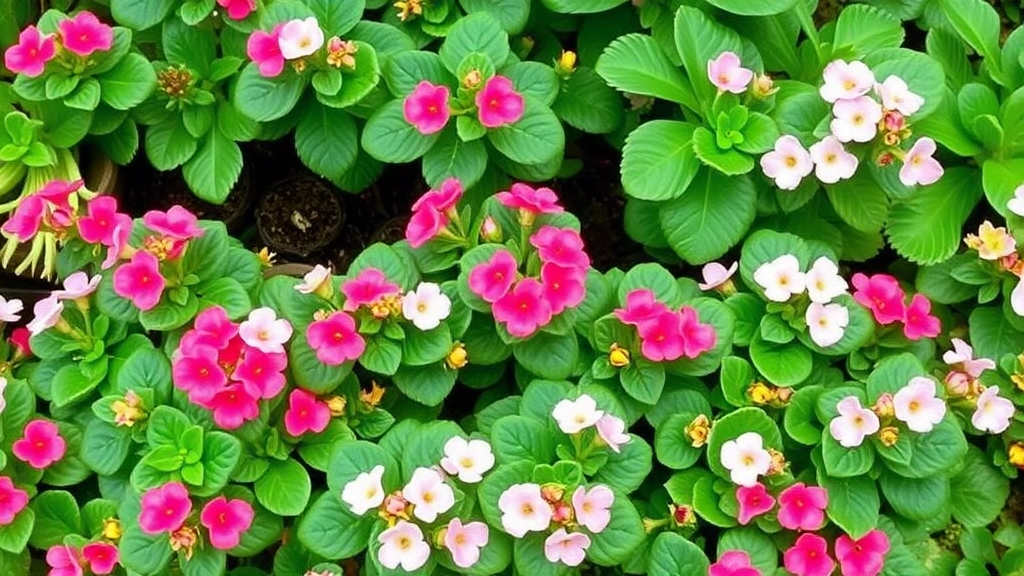
Are you looking to add some vibrant greenery to your home? Kalanchoe species might just be the perfect choice. These succulents are not only stunning but also relatively easy to care for.
Let’s dive into some of the most popular Kalanchoe varieties that you can easily grow at home.
1. Kalanchoe Blossfeldiana
You’ve probably seen this beauty in garden centres. Known for its clusters of bright flowers, Kalanchoe Blossfeldiana is a real showstopper.
- Flowers: Comes in various colours like red, pink, and yellow.
- Care: Prefers bright light but can tolerate some shade.
2. Kalanchoe Tomentosa (Panda Plant)
With its fuzzy leaves, the Panda Plant is a favourite among succulent lovers.
- Leaves: Silvery-green with brown edges, resembling panda ears.
- Care: Thrives in bright, indirect sunlight.
3. Kalanchoe Thyrsiflora (Flapjacks)
This one’s a conversation starter! Flapjacks have thick, pancake-like leaves that can turn a stunning red in bright sunlight.
- Appearance: Large, round leaves stacked like pancakes.
- Care: Needs plenty of sunlight to show off its colours.
4. Kalanchoe Luciae (Paddle Plant)
Similar to Flapjacks, the Paddle Plant has a unique shape and vibrant colours.
- Leaves: Thick, paddle-shaped, and can develop a reddish hue.
- Care: Enjoys full sun and well-draining soil.
5. Kalanchoe Marmorata (Pencil Plant)
This one’s a bit different. The Pencil Plant has striking marbled leaves that really catch the eye.
- Leaves: Green with greyish spots that give it a unique look.
- Care: Prefers bright light and can tolerate drought.
These Kalanchoe species are just a few examples of what you can bring into your home. Each variety has its own charm and care requirements, making it easy to find one that fits your lifestyle.
When exploring Kalanchoe species, it’s essential to understand the distinctions between common and rare varieties. This not only enhances your gardening experience but also aids in making informed choices for your collection.
### Common Kalanchoe Varieties
Common Kalanchoe species are widely available and often found in garden centres and nurseries. They are typically more resilient and easier to care for. Here are a few key traits:
– **Kalanchoe blossfeldiana**: Known for its vibrant flowers, this species is popular for indoor decoration. For more detailed care tips, you can refer to the [complete care guide for Kalanchoe blossfeldiana succulent](https://planthq.org/complete-care-guide-for-kalanchoe-blossfeldiana-succulent/).
– **Kalanchoe tomentosa**: Often called the “Panda Plant,” it’s recognised for its fuzzy leaves and is a favourite among beginners.
– **Kalanchoe luciae**: Also known as “Flapjack,” it features stunning, large, flat leaves that turn red at the edges under bright sunlight.
### Rare Kalanchoe Varieties
On the other hand, rare Kalanchoe species may require more specialised care. They often have unique characteristics that make them sought after by collectors. Some notable examples include:
– **Kalanchoe marnieriana**: Known for its striking, tubular flowers and attractive foliage, it thrives in specific conditions.
– **Kalanchoe beharensis**: With its large, elephant-ear-like leaves, this variety is less common and can be challenging to cultivate. For more information, check out the [complete care guide for Kalanchoe beharensis felt plant](https://planthq.org/complete-care-guide-for-kalanchoe-beharensis-felt-plant/).
– **Kalanchoe orgyalis**: This species features a distinctive, velvety texture and requires careful attention to humidity levels.
### Key Differences
– **Availability**: Common varieties are readily accessible, while rare species may require sourcing from specialised nurseries or online platforms.
– **Care Requirements**: Common Kalanchoes are generally more forgiving, while rare varieties may need specific conditions, such as particular soil types or humidity levels.
– **Aesthetic Appeal**: Rare Kalanchoes often have unique appearances that can make them more desirable for collectors.
Understanding these differences can significantly influence your gardening decisions.
Leaf Shapes and Textures as Identification Markers
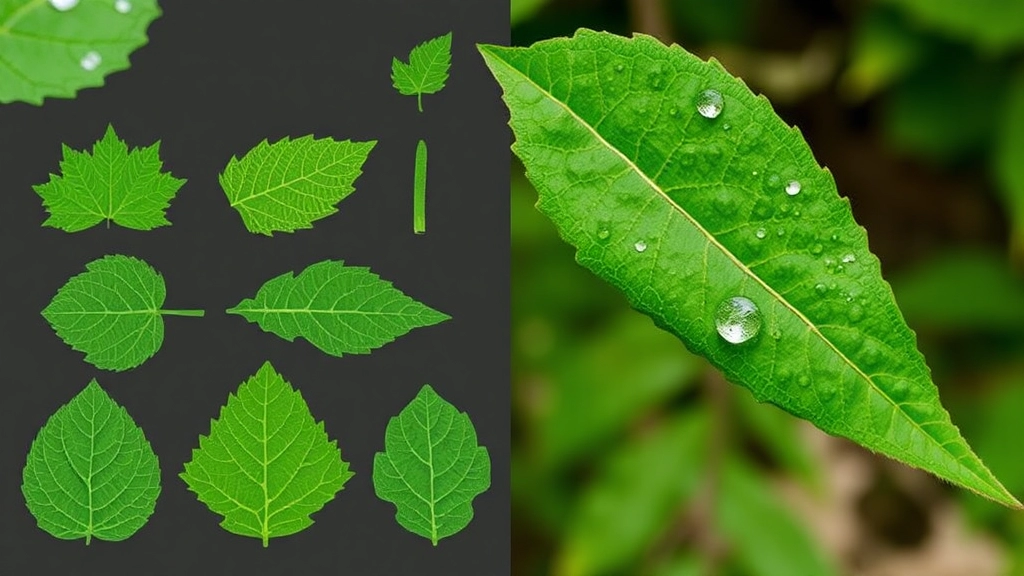
When trying to identify different Kalanchoe species, one of the most striking features to consider is the leaf shape and texture.
Do you often find yourself confused by the variety of Kalanchoe leaves?
Understanding these characteristics can make a significant difference in your identification efforts.
Leaf Shapes
Kalanchoe leaves can vary widely in shape, and this diversity is a key marker for identification. Here are some common shapes you might encounter:
- Round: Some species, like Kalanchoe luciae, have thick, rounded leaves that can resemble a paddle.
- Lanceolate: Kalanchoe tomentosa features elongated, lance-shaped leaves that taper at both ends.
- Ovate: Kalanchoe blossfeldiana sports ovate leaves that are broad and rounded at the base.
Leaf Textures
Texture is equally important in distinguishing Kalanchoe species.
Different textures can indicate adaptations to their environments:
- Smooth: Many Kalanchoe varieties have smooth, glossy leaves that retain moisture efficiently.
- Fuzzy: Species like Kalanchoe tomentosa have a velvety texture due to fine hairs, which help reduce water loss.
- Waxy: Some species possess a waxy coating, providing an extra layer of protection against harsh conditions.
Why This Matters
Recognising these leaf shapes and textures not only aids in identification but also offers insights into the plant’s care requirements.
For example, smooth-leaved varieties may require more frequent watering, while fuzzy-leaved types might thrive in drier conditions.
Flowering Patterns and Seasonal Changes in Kalanchoe
One of the most captivating aspects of Kalanchoe species is their unique flowering patterns and how these can change with the seasons.
Have you ever wondered why some Kalanchoe plants bloom profusely while others seem to shy away from flowers?
Flowering Patterns:
- Seasonal Blooming: Most Kalanchoe species, such as Kalanchoe blossfeldiana, tend to bloom in late winter to early spring. This is when they receive longer daylight hours, triggering their flowering cycle.
- Continuous Blooms: Some varieties, like Kalanchoe thyrsiflora, can produce flowers intermittently throughout the year, depending on environmental conditions.
- Color Variations: The flowers can range from vibrant reds and pinks to soft yellows and whites, making them visually striking additions to any garden.
Seasonal Changes:
- Temperature Influence: Kalanchoe thrive in warmer temperatures. As the weather cools, their growth slows, and flowering may cease until conditions improve.
- Watering Schedule: During blooming periods, it’s essential to maintain an appropriate watering schedule. Overwatering can lead to root rot, while underwatering can cause stress, leading to fewer blooms.
- Light Requirements: Adequate sunlight is crucial for flowering. A south-facing window or a spot that receives bright, indirect light is ideal. For more detailed information, refer to our Kalanchoe care tips and growing guide.
Geographic Origins of Kalanchoe Species and Their Adaptations
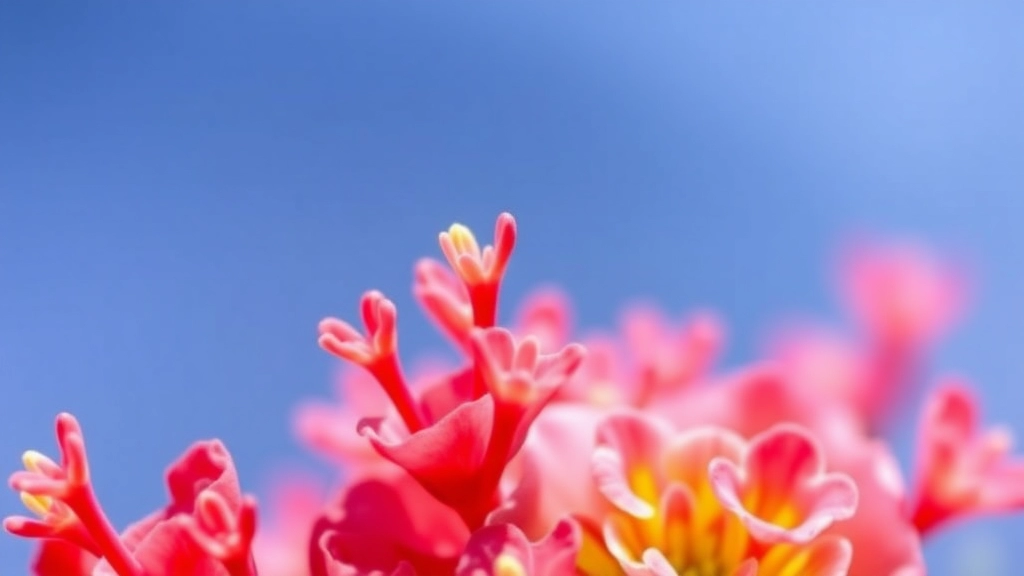
Ever wondered where Kalanchoe species come from?
These fascinating plants have roots in various parts of the world, each with its own unique adaptations to thrive in different environments.
Origins
- Africa: Many Kalanchoe species hail from Madagascar and other African regions. They’ve adapted to survive in arid climates, which means they’re excellent at storing water.
- Asia: Some varieties are native to tropical areas in Asia, where they’ve developed a knack for thriving in humidity and warmth.
- Central and South America: A few species can be found in these regions, showcasing their ability to adapt to a range of soil types and weather conditions.
Adaptations
Understanding their origins helps us appreciate how Kalanchoe species have adapted:
- Water Storage: Their thick, fleshy leaves are perfect for retaining moisture, a must in dry habitats.
- Sunlight Tolerance: Many can handle direct sunlight, thanks to their ability to store energy and moisture.
- Temperature Resilience: Some species can endure cooler temperatures, making them versatile for different climates.
For instance, Kalanchoe tomentosa, commonly known as the Panda Plant, thrives in bright, indirect light and showcases fuzzy leaves that help reduce moisture loss.
Common Confusions in Kalanchoe Identification
When diving into the world of Kalanchoe, many enthusiasts find themselves perplexed by the sheer variety and similarities among species.
Care Tips Based on Specific Kalanchoe Varieties
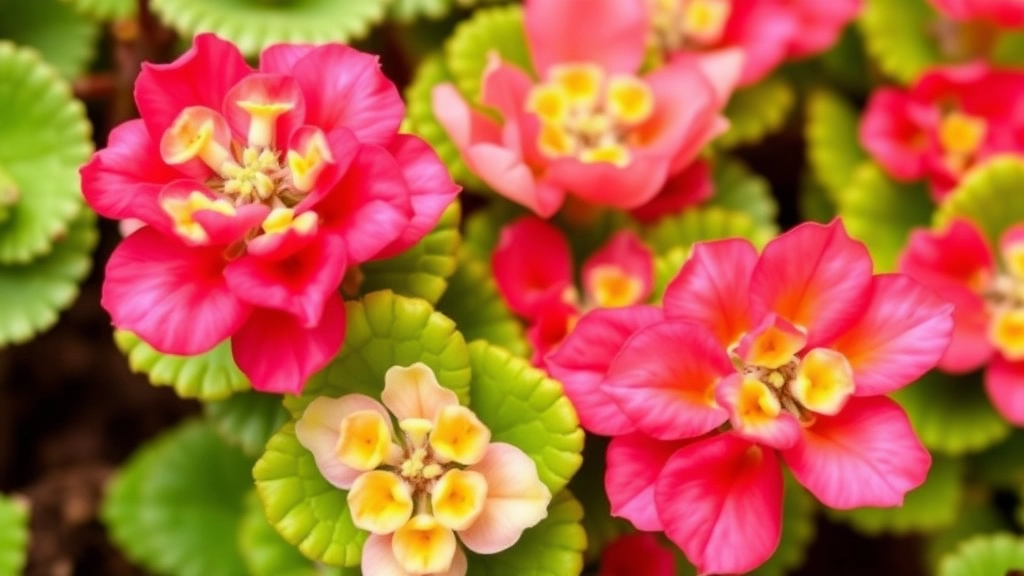
So, you’ve got your Kalanchoe and you’re wondering how to keep it thriving?
Different Kalanchoe species have unique needs, and knowing these can make all the difference in your gardening success.
General Care Tips
- Light: Most Kalanchoe love bright, indirect sunlight.
- Watering: Let the soil dry out between waterings. Overwatering is a common mistake!
- Soil: Use well-draining soil. A cactus mix works wonders.
- Temperature: They prefer warmer temperatures, ideally between 18-24°C.
Specific Variety Care
Kalanchoe blossfeldiana (Flaming Katy)
- Light: Likes full sun for at least six hours a day.
- Watering: Water less during its dormant phase (winter).
- Fertilizer: Feed with a balanced fertiliser every few weeks during the growing season.
Kalanchoe tomentosa (Panda Plant)
- Light: Thrives in bright, indirect light.
- Watering: Be careful; it’s more drought-tolerant. Water sparingly.
- Humidity: Prefers lower humidity—keep it away from steamy bathrooms.
Kalanchoe luciae (Paddle Plant)
- Light: Needs lots of sunlight; direct sun is ideal.
- Watering: Water when the soil is completely dry.
- Temperature: Enjoys a warmer climate; keep it above 10°C.
Kalanchoe beharensis (Elephant Bush)
- Light: Can handle low light but flourishes in bright light.
- Watering: Allow the soil to dry out completely between waterings.
- Growth: Prune to maintain shape and encourage bushiness.
Common Mistakes to Avoid
- Overwatering: This is the number one killer of Kalanchoe.
- Poor Drainage: Always use pots with drainage holes.
- Neglecting Pruning: Regular pruning keeps your plant healthy and encourages new growth.
How to Distinguish Between Similar-Looking Succulents and Kalanchoe Species
Identifying Kalanchoe species can be a challenge, especially when they share features with other succulents. Many plant enthusiasts often find themselves puzzled over whether they have a Kalanchoe or a different succulent variety.
Common Confusions
Here are some key points to help you differentiate Kalanchoe from similar-looking succulents:
- Leaf Structure: Kalanchoe typically has thick, fleshy leaves that can be smooth or slightly textured.
- Growth Habit: Kalanchoe species often exhibit a rosette formation, whereas other succulents like Echeveria may have a more compact or varied growth pattern.
- Flowers: Kalanchoe is known for its distinctive clusters of tubular flowers, which can vary in colour. If you see vibrant blooms, it’s likely a Kalanchoe.
- Stem Characteristics: Kalanchoe species often have a more upright growth with thicker stems compared to other succulents, which may trail or spread out.
Key Identifiers
To simplify your identification process, consider these identifiers:
- Colour: Kalanchoe leaves can range from green to grey-green, often with a waxy finish.
- Edges: Some Kalanchoe species have serrated or scalloped leaf edges, which can be a giveaway.
- Texture: Pay attention to the leaf texture; Kalanchoe leaves may feel more rubbery compared to others.
Examples of Confusion
For instance, Kalanchoe tomentosa, commonly known as Panda Plant, can be mistaken for other fuzzy succulents like certain types of Senecio.
To further enhance your identification skills, I recommend keeping a reference guide handy or using plant identification apps. For more detailed information, you can check out the Kalanchoe Succulent Identification Guide or learn more about different Kalanchoe species for your garden.
FAQs on Kalanchoe Species Identification and Care
What are some popular Kalanchoe species for home gardening?
Kalanchoe species are excellent choices for home gardening due to their vibrant appearance and ease of care. Some popular varieties include:
- Kalanchoe Blossfeldiana: Known for its bright flower clusters.
- Kalanchoe Tomentosa (Panda Plant): Features fuzzy, panda-ear-like leaves.
- Kalanchoe Thyrsiflora (Flapjacks): Has thick, pancake-like leaves that turn red in bright sunlight.
- Kalanchoe Luciae (Paddle Plant): Similar to Flapjacks with paddle-shaped leaves.
- Kalanchoe Marmorata (Pencil Plant): Known for its striking marbled leaves.
How can I identify different Kalanchoe species?
Identifying Kalanchoe species often involves examining leaf shapes and textures:
- Leaf Shapes: Round, lanceolate, and ovate are common shapes.
- Leaf Textures: Smooth, fuzzy, and waxy textures can help in identification.
What are the geographic origins of Kalanchoe species?
Kalanchoe species originate from various parts of the world, each with unique adaptations:
- Africa: Many species come from Madagascar and other African regions.
- Asia: Some varieties are native to tropical areas in Asia.
- Central and South America: A few species are found in these regions.
What are some general care tips for Kalanchoe plants?
To keep your Kalanchoe thriving, follow these general care tips:
- Light: Most Kalanchoe prefer bright, indirect sunlight.
- Watering: Let the soil dry out between waterings.
- Soil: Use well-draining soil, such as a cactus mix.
- Temperature: Ideal temperatures range between 18-24°C.
Are there specific care requirements for different Kalanchoe varieties?
Yes, each Kalanchoe variety has unique needs:
- Kalanchoe Blossfeldiana: Prefers full sun and less water during its dormant phase.
- Kalanchoe Tomentosa: Thrives in bright, indirect light and requires sparing watering.
- Kalanchoe Luciae: Needs lots of sunlight and should be watered when the soil is completely dry.
- Kalanchoe Beharensis: Can handle low light but flourishes in bright light; allow soil to dry out completely between waterings.
What common mistakes should I avoid when caring for Kalanchoe plants?
To ensure your Kalanchoe stays healthy, avoid these common mistakes:
- Overwatering: This is the number one killer of Kalanchoe.
- Poor Drainage: Always use pots with drainage holes.
- Neglecting Pruning: Regular pruning keeps your plant healthy and encourages new growth.
References
-
Growing Kalanchoe Succulents
-
Kalanchoe Plant Care
-
Kalanchoe: How to Grow and Care for Kalanchoe Plants
